Trees aren’t just good for offering fruits and saving the environment, they’re a great addition to any landscape.
Of the many places you can plant a tree in your environment, the pool area is one place trees offer multiple benefits.
When you get trees for your pool area, you get a natural source of shade. But that’s not all.

The trees will also add some aesthetics to the scenery and improve the air around the area.
If you are considering adding a tree for your pool area, we’ve got some options that you can try out.
This piece goes over some of the best trees for a pool area.
Before we proceed with the list, let’s answer a few vital questions.
Table of Contents
How Far Does the Pool Need to Be From a Tree?
Generally, it is advised that you keep your pool at least 15 feet from any tree trunk.
But if there’s even more space, you should aim to keep your pool outside the perimeter of the tree’s drip line.
You may also have to remove some large branches that may affect the pool.
But in such cases, you should get an expert to do that.
There are a number of other ways trees can interfere with your pool if not well-spaced.
The roots of the trees, for one, can damage your pool. This might be less likely with concrete pools and one-piece pools, but it is more likely with a liner pool.
Besides the roots, the fruits, nuts, and seeds from trees can litter your pool as they drop.
Even leaves might be a problem, although to a lesser extent.
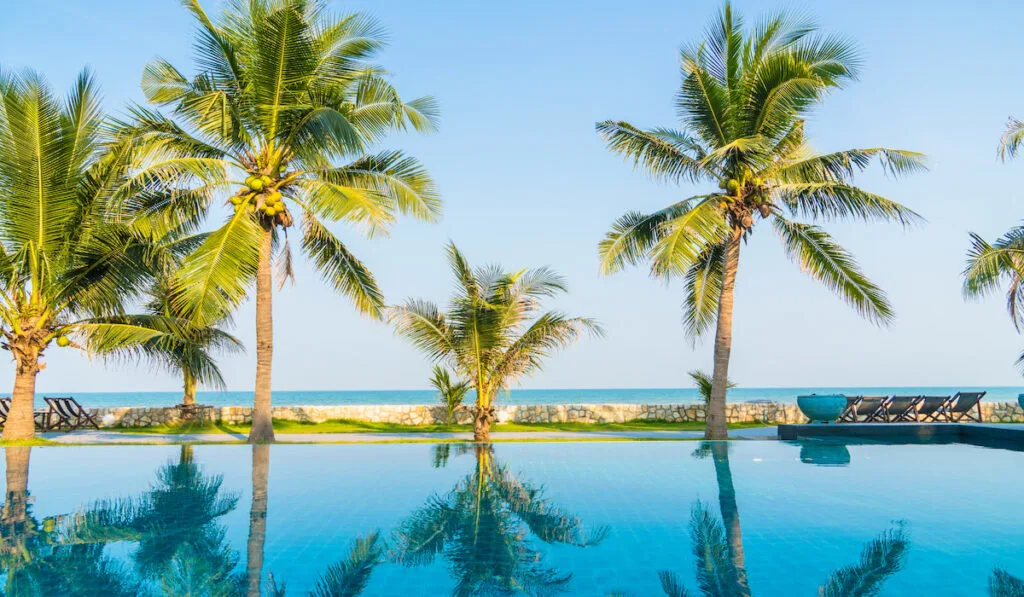
Will the Pool Chlorine Kill a Tree?
While trees can have adverse effects on your pool if poorly-spaced, pools may also affect your trees.
The water in pools is usually treated with chemicals to improve its quality. One of the most common of such chemicals is chlorine.
While chlorine is perfectly fitting for human use, it could make the surrounding trees sick.
Water containing chlorine at concentrations as low as 0.5 parts per million can cause problems for your tree.
In fact, some trees like Crabapple, Dogwood, and Pin Oak might be affected by even lower chlorine concentrations.
Besides chlorine concentration, some other factors also affect chlorine toxicity in trees.
These factors are the amount of pool water that gets to the tree, duration of exposure, and state of the tree (dormant or growing).
So, what signs do you see when a tree is experiencing chlorine toxicity?
The first signs of chlorine toxicity in a tree will be seen on the leaves.
Such leaves would appear burned and brown with some dead tissues around the edges.
Some other leaves may become yellow and stunted, then bud off early.
Chlorine toxicity could ultimately end up causing the death of your tree. But this can be avoided.

Some of the ways to avoid chlorine toxicity are:
- You could use milder alternatives to chlorine to disinfect your pool. One alternative is distilled white vinegar.
- Do not chlorinate your pool for at least a week before draining it. This way, the chlorine will have dissipated before you drain it.
- Before draining, ensure you test the pH of the pool water. The pH should be between 7 and 8 before you drain the water.
- Do not drain all at once.; drain slowly so the soil can absorb the water gradually.
What do you do if you notice your tree has been affected by chlorinated water? The easiest thing to do is irrigate the soil with plenty of non-chlorinated water.
The chlorine-free water will dilute the chlorine in the soil and leach it away.
You could also add gypsum to the soil to remove the chlorine. Add about 58 lbs. of gypsum for every 1000 square ft. of topsoil.
If the options above do not help, you should call in an expert.
Two Types of Trees for Around the Pool
So, when you are getting trees for pool area, you could consider getting them for various reasons.
However, our list will focus on 2 main types of trees for around the pool:
- Ornamentals – these types are kept for beautification.
- Privacy Trees – these types are used as privacy screens.
19 Best Trees for Pool Area
Acacia

Maximum Height: 20 to 40 feet
Ornamental or Privacy: Both
Does It Drop Litter: Low litter
Root Depth/Width: A species of Acacia (Acacia mangium) has been shown to grow as wide as 21 feet after 21 months.
Fruitless Olive Tree
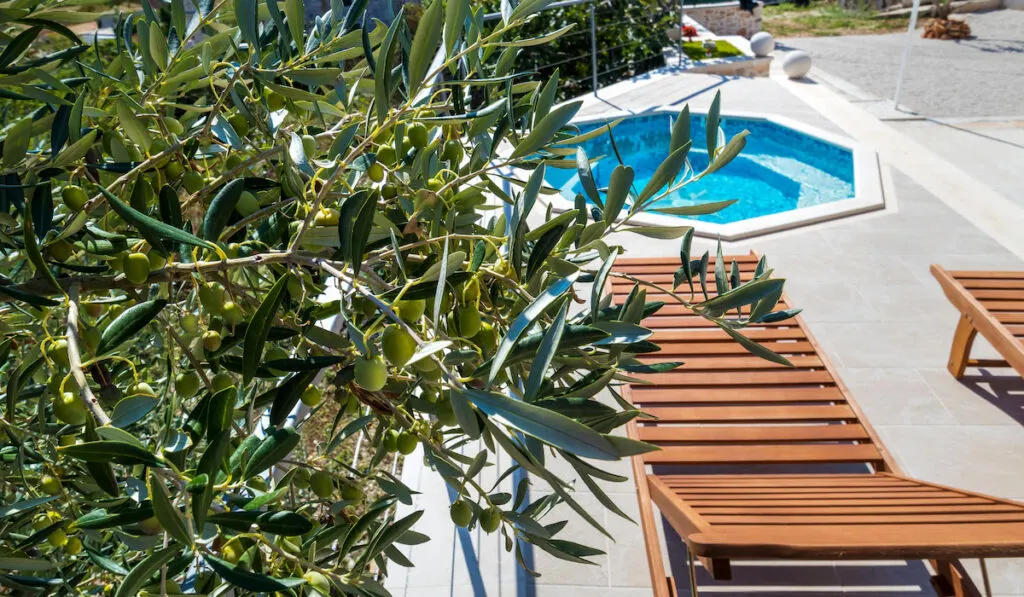
Maximum Height: 30 feet
Ornamental or Privacy: Both
Does It Drop Litter: Relatively litter-free, especially the Majestic Beauty
Root Depth/Width: Typically depends on the nature of the soil but widths up to 40 feet and depths up to 20 feet have been reported.
Windmill Palm
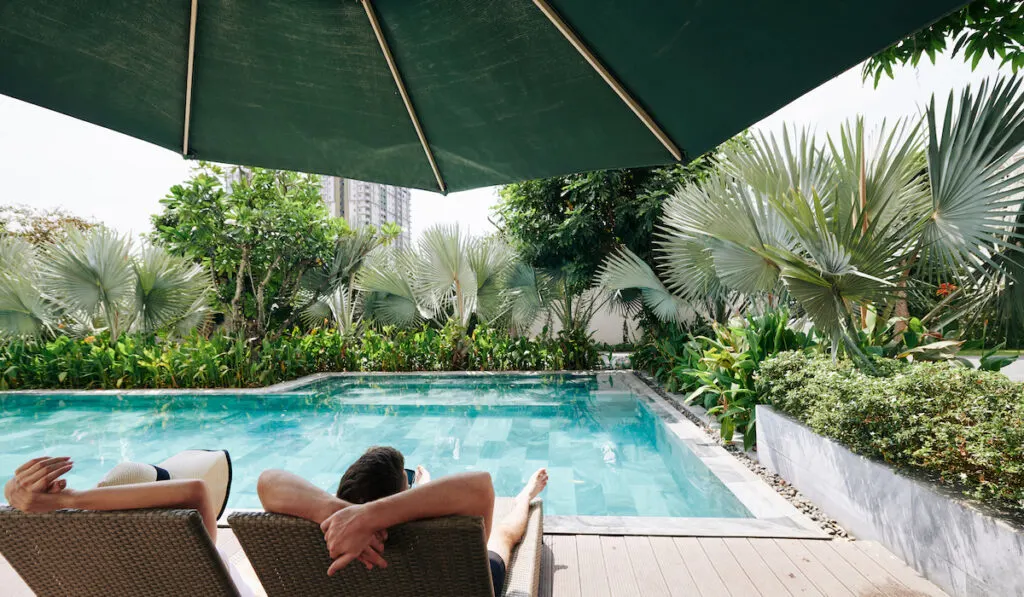
Maximum Height: 40 feet
Ornamental or Privacy: Privacy
Does It Drop Litter: No
Banana
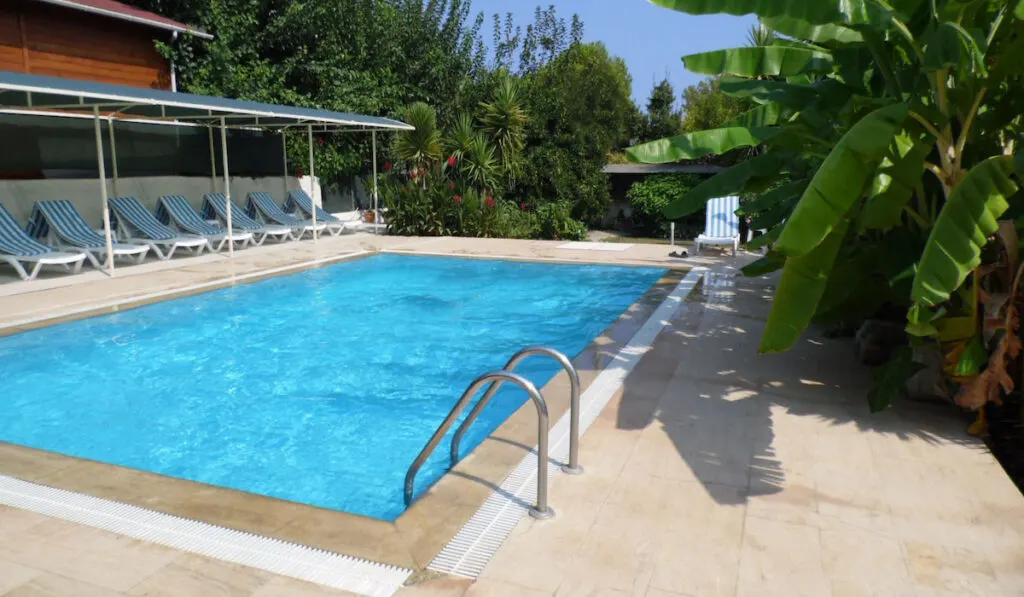
Maximum Height: 10-23 feet
Ornamental or Privacy: Privacy although some varieties can be ornamental
Does It Drop Litter: No
Root Depth/Width: 5 feet deep and 16 feet wide
Citrus
Maximum Height: 18-22 feet
Ornamental or Privacy: Both
Does It Drop Litter: Drops leaves when it is forming fruits and when it is blossoming. But even then, not many. Citrus also drop leaves in winter.
Root Depth/Width: 2-3 feet deep
Cypress
Maximum Height: 50-80 feet
Ornamental or Privacy: Privacy
Does It Drop Litter: Yes, in the fall
Root Depth/Width: The roots extend 20-50 feet horizontally. But they only reach depths slightly below the soil surface.
Magnolia
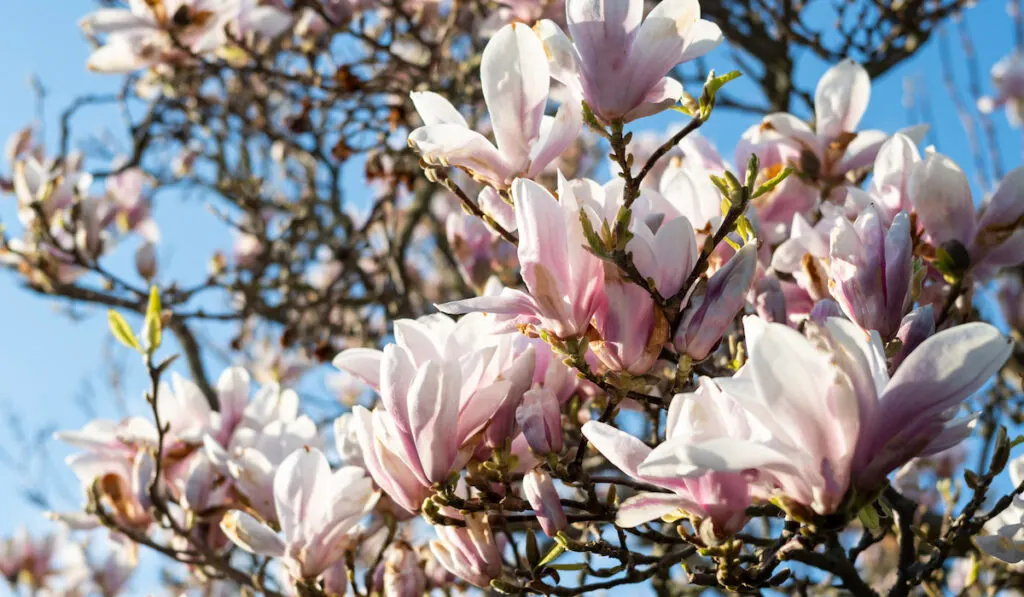
Maximum Height: 80 feet
Ornamental or Privacy: Both
Does It Drop Litter: Yes
Root Depth/Width: The root width is about 4 times the diameter of the tree canopy.
Arborvitae
Maximum Height: 40-60 feet
Ornamental or Privacy: Privacy
Does It Drop Litter: No. They typically drop their leaves in the fall. But Dwarf Arborvitaes are noted to litter considerably.
Root Depth/Width: 0.7-2 feet deep
Oleander
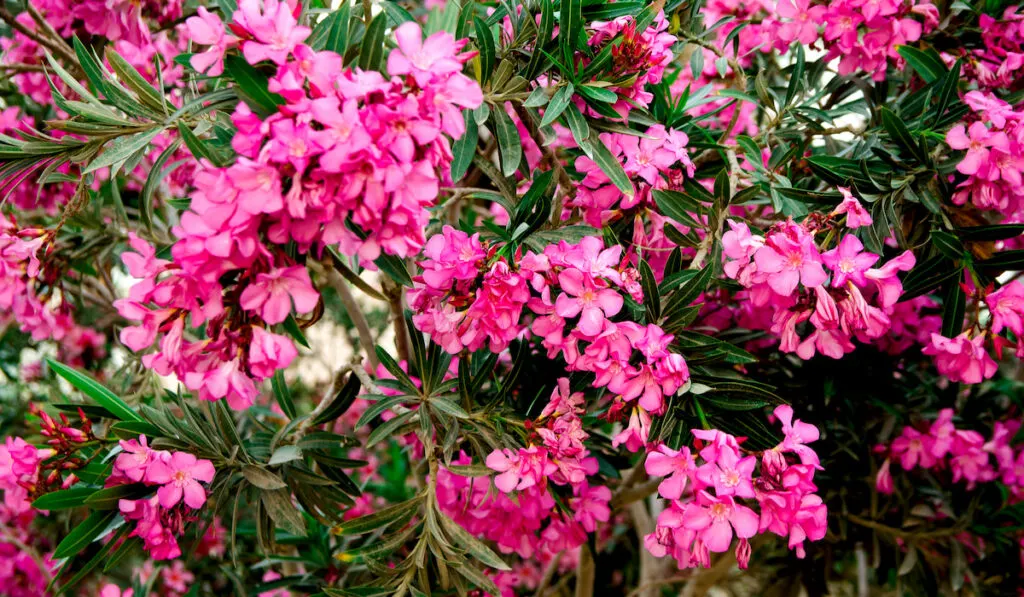
Maximum Height: 8-12 feet
Ornamental or Privacy: Both
Does It Drop Litter: No
Root Depth/Width: As wide as 12 feet
Spruce
Maximum Height: 60-200 feet
Ornamental or Privacy: Both
Does It Drop Litter: Spruce trees usually start dropping needles after 2-3 years.
Root Depth/Width: About 1 foot deep
Holly
Maximum Height: 100 feet
Ornamental or Privacy: Privacy
Does It Drop Litter: Holly trees usually only drop leaves in spring.
Root Depth/Width: 1.4-2.1 feet deep
Cane Palm
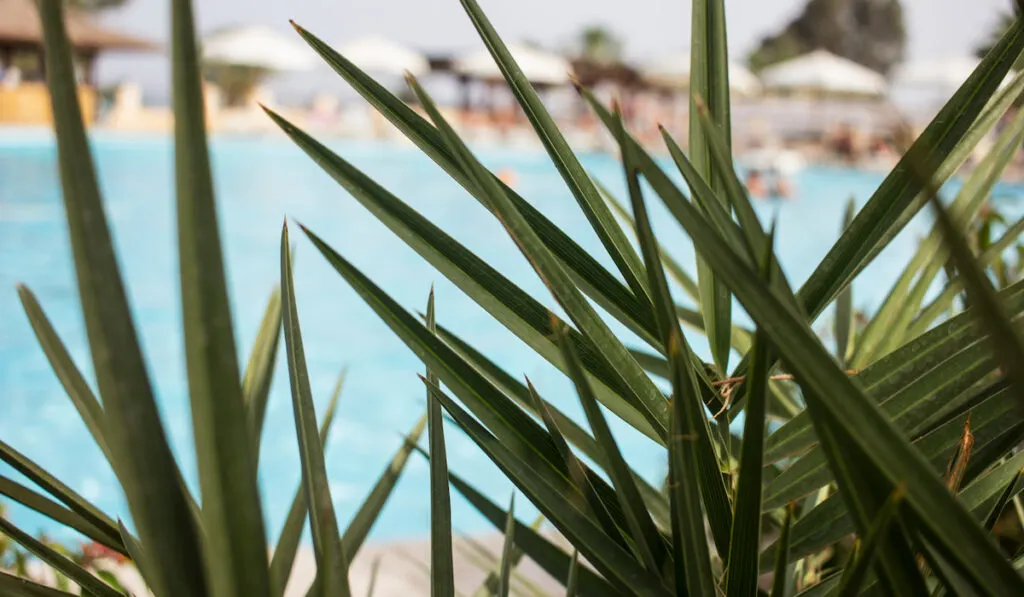
Maximum Height: 20-39 feet
Ornamental or Privacy: Ornamental
Does It Drop Litter: No.
Root Depth/Width: 3.3 feet deep
Sago Palm
Maximum Height: 10-12 feet
Ornamental or Privacy: Ornamental
Does It Drop Litter: No
Root Depth/Width: At least 1 foot
Sabal Palm
Maximum Height: 40-50 feet
Ornamental or Privacy: Ornamental
Does It Drop Litter: No
Root Depth/Width: About 3.3 feet
Japanese Maple
Maximum Height: 30 feet
Ornamental or Privacy: Ornamental
Does It Drop Litter: No
Root Depth/Width: Up to 3 feet deep and 12 feet wide
Desert Ironwood
Maximum Height: 45 feet
Ornamental or Privacy: Ornamental
Does It Drop Litter: It does during drought, but monthly watering can prevent this.
Floss Silk
Maximum Height: 50 feet
Ornamental or Privacy: Ornamental
Does It Drop Litter: No
Palo Verde
Maximum Height: 20-40 feet
Ornamental or Privacy: Both
Does It Drop Litter: Insignificant amount
Queen Palm
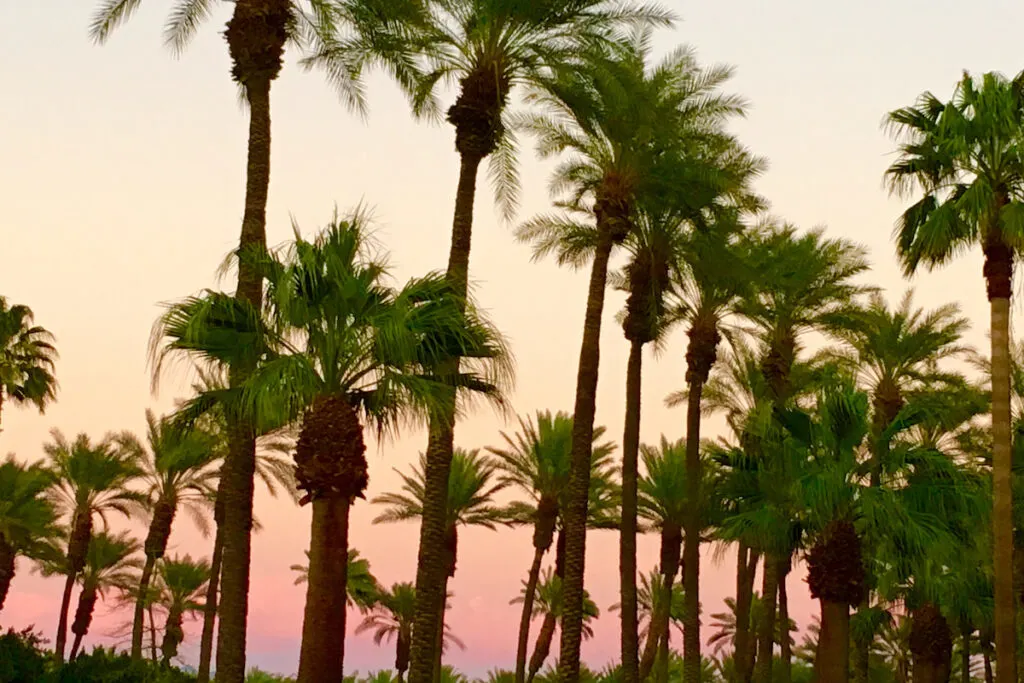
Maximum Height: 50 feet
Ornamental or Privacy: Ornamental
Does It Drop Litter: No
Root Depth/Width: 1-4 feet deep and up to 12 feet wide
Resources
- https://3daypools.ca/questions-to-ask-before-dealing-with-trees-near-your-pool/
- https://xlpools.com/pool-construction-trees/
- https://www.riverpoolsandspas.com/blog/inground-pool-construction-and-trees-faq
- https://bartstreeservice.com/chlorine-damage-pool-draining-kills-trees/
- https://homeguides.sfgate.com/chlorinated-water-tree-damage-22980.html
- https://ownthepool.com/how-to-keep-a-kiddie-pool-clean/
- https://blog.intheswim.com/best-worst-trees-to-plant-around-a-pool/
- https://www.thespruce.com/the-best-trees-for-pool-landscaping-2736712
- https://www.gardeningchannel.com/how-to-grow-acacia-tree/
- https://wateruseitwisely.com/plant-of-the-month-acacia
- https://www.jstor.org/stable/23616005?seq=1
- https://www.horticultureunlimited.com/plant-guide/fruitless-olive/
- https://www.thespruce.com/fruitless-olive-tree-profile-4158521
- https://garden.org/frogs/view/29559/
- https://wikifarmer.com/olive-tree-information/
- https://www.thespruce.com/palm-trees-turn-yard-into-paradise-2736711
- https://newswire.caes.uga.edu/story.html?storyid=4046
- http://agroforestry.net/tti/Musa-banana-plantain.pdf
- http://agroforestry.net/tti/Banana-plantain-overview.pdf
- https://buyevergreenshrubs.com/a-privacy-tree-that-grows-10-feet-a-year/
- https://myperfectplants.com/grow-guides/ornamental-bananas
- https://homeguides.sfgate.com/banana-trees-root-system-54280.html
- http://www.scielo.br/scielo.php
- https://homeguides.sfgate.com/lemon-trees-lose-leaves-suddenly-55086.html
- https://www.redding.com/story/life/2019/09/13/why-my-meyer-lemon-tree-dropping-its-leaves/2296206001/
- https://www.greenthumb.com/citrus-for-privacy
- https://www.almanac.com/plant/lemons-oranges
- https://plants.usda.gov/factsheet/pdf/fs_tadi2.pdf
- https://www.gardeningknowhow.com/ornamental/trees/cypress/bald-cypress-information.htm
- https://www.budgetdumpster.com/blog/best-trees-for-privacy
- https://www.gardeningknowhow.com/ornamental/trees/cypress/growing-cypress-trees.htm
- https://www.gardeningknowhow.com/ornamental/trees/magnolia/are-magnolia-roots-invasive.htm
- https://aggie-horticulture.tamu.edu/southerngarden/magnolia.html
- https://www.southernliving.com/home-garden/gardens/magnolia-trees
- https://bbbarns.com/garden-blog/2018/1/26/five-trees-for-screening
- https://www.thespruce.com/twelve-species-magnolia-trees-and-shrubs-3269666
- https://ask.extension.org/questions/360261
- https://www.lurveys.com/blog/how-arborvitaes-shed
- https://www.instanthedge.com/privacy-hedges
- https://www.arborday.org/trees/treeguide/TreeDetail.cfm?ItemID=776
- https://homeguides.sfgate.com/far-away-sewer-lines-should-plant-oleander-85019.html
- https://edis.ifas.ufl.edu/st413
- https://www.thespruce.com/oleander-2681587
- https://homeguides.sfgate.com/shrubs-plant-privacy-53618.html
- https://hgic.clemson.edu/factsheet/oleander/
- https://www.thespruce.com/dwarf-alberta-spruces-are-dropping-needles-2132835
- https://salisburygreenhouse.com/under-the-spruce-tree/
- https://extension.purdue.edu/article/29053
- https://www.britannica.com/plant/spruce
- https://dengarden.com/landscaping/The-Best-Evergreen-Trees-for-Privacy
- https://www.plantgardener.com/do-holly-trees-have-deep-roots
- https://www.gardeningknowhow.com/ornamental/shrubs/holly/holly-leaf-loss-in-spring.htm
- https://www.bobvila.com/slideshow/the-best-10-plants-to-grow-for-backyard-privacy-50057
- https://plants.usda.gov/factsheet/pdf/fs_ilop.pdf
- https://palms.org/litter-trapping-palms
- https://pottingplans.com/palm-tree-roots
- https://www.daleysturf.com.au/golden-cane-palms-and-your-lawn/
- https://homeguides.sfgate.com/dig-up-sago-palm-82054.html
- https://homeguides.sfgate.com/different-sizes-sago-palms-103548.html
- https://www.thespruce.com/messy-plants-keep-away-from-pool-2736704
- https://pottingplans.com/palm-tree-roots
- http://hort.ufl.edu/trees/SABPALA.pdf
- https://www.japanesemaplesonline.com/index.cfm/fuseaction/home.showpage/pageID/11/index.htm
- https://edis.ifas.ufl.edu/st023
- https://www.gardeningknowhow.com/ornamental/trees/japanese-maple/japanese-maple-companions.htm
- https://www.monrovia.com/be-inspired/how-to-select-the-right-japanese-maple.html
- https://gardenoracle.com/images/olneya-tesota.html
- https://www.hortmag.com/plants-we-love-2/desert-ironwood-is-a-super-tree-for-the-southwest
- https://cals.arizona.edu/maricopa/garden/html/pubs/0803/ironwood.html
- https://edis.ifas.ufl.edu/st164
- https://animals.sandiegozoo.org/plants/floss-silk-tree
- https://hort.ifas.ufl.edu/database/documents/pdf/tree_fact_sheets/chospea.pdf
- https://www.succulentsandmore.com/2015/06/palo-verde-messiness-update.html
- https://www.visaliatimesdelta.com/story/life/home-garden/2015/09/10/palo-verde-tree-good-drought-tolerant-choice/72017412
- https://www.latimes.com/home/la-lh-hedge-plants-privacy-20130425-story.html
- https://www.desertusa.com/flora/palo-verde-tree.html
- https://www.hunker.com/13428846/what-is-the-root-base-of-a-queen-palm-tree
- https://www.gardeningknowhow.com/houseplants/queen-palms/how-to-grow-queen-palm-outdoors.htm
- http://hort.ufl.edu/database/documents/pdf/tree_fact_sheets/syaroma.pdf
